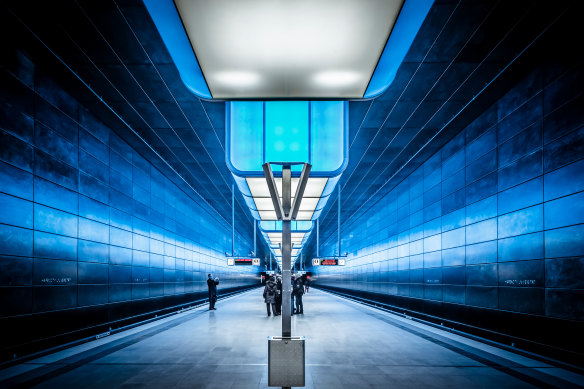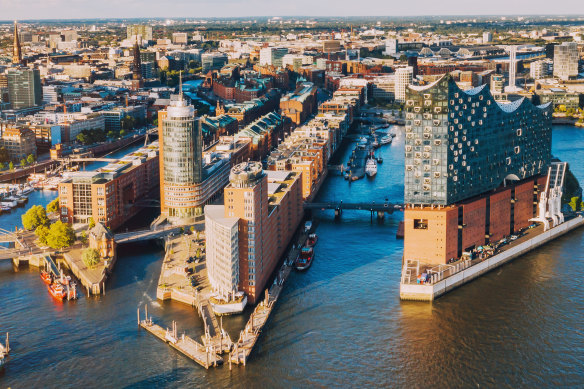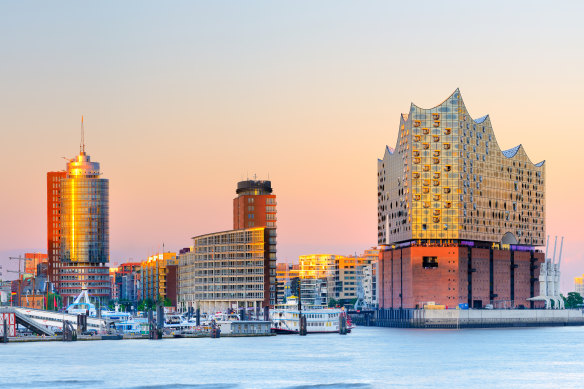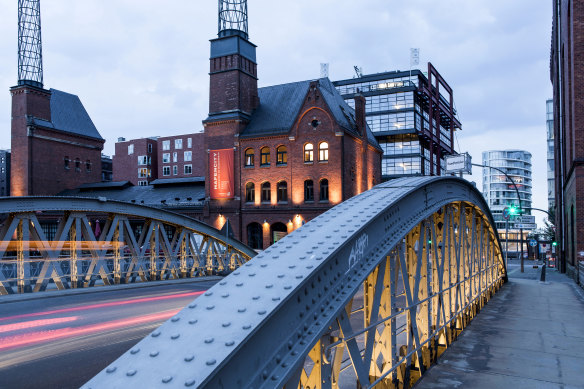This was published 1 year ago
Forget castles and chintzy town squares: This is cool new Europe
Hamburg is one of Europe’s most rapidly changing cities, especially on its spectacularly redeveloped waterfront. Small wonder Germans vote it the best place for a visit.
For every thousand tourists who’ve eaten gingerbread, swilled beer and clambered around battlements in Bavaria, only one has made it to Hamburg.
Tourists persist in experiencing Europe only through the prism of its supposedly merry history. The old is quaint and interesting. Modern Europe is moribund, beset with problems and obsessed with the past.

The architecture of HafenCity, Hamburg.
Yet you only have to lift your head from the guidebooks, step off the tourist trail and focus on the present to realise how blinkered this narrative of unchanging, backward-looking Europe can be.
Visit Hamburg and you’ll find a hearty slice of forward-thinking, open-minded, fast-moving contemporary Europe – and the city many Germans nominate as their favourite urban destination.
You won’t find much obvious history. Hamburg is a millennium years old but was heavily bombed during World War II. Only 10 per cent of its structures survived.
Its few medieval buildings – there are two rather wonderful Gothic churches – stick out like reproaches amid the post-war concrete. Go elsewhere if you’re after predictable gargoyles, cherubs and ghost tours.
What Hamburg does have is spirit, contemporary vigour and good art museums. It has a raucous nightlife, especially around St Pauli which, despite being a notorious red-light district, is a hip gathering spot for the young and tolerant.
And Hamburg has one of Germany’s top music scenes. The Beatles started their careers here in the 1960s – Beatles tours are a staple for British weekend visitors – and live music venues abound.
But what you really want to do in Hamburg is get down to the waterfront, where the city is at its most interesting. This is where things have been happening since Hamburg was granted a special imperial trading charter in the 12th century, which made it rich. Water is the city’s lifeblood, and today the waterfront is redefining the city.
First, visit Speicherstadt for background. In the 19th century, this was Hamburg’s cutting-edge, fast-changing waterfront district.

HafenCity and Hamburg’s waterways from the air.Credit: iStock
Now Speicherstadt is World Heritage listed for its enormous brick warehouses, which sport a whimsy of pseudo-Gothic turrets and gables. Canal bridges make for striking vantage points, especially at sunset, when canal-scapes of red brick glow.
One vast warehouse – 10 floors high and castle-like in dimensions – has been converted into the International Maritime Museum, which puts Hamburg’s sea-trading history into context. If you like model ships, you’ll be in raptures.
Outside, street names such as Java, Ceylon and Shanghai are a reminder of the spices, coffee, tea and tobacco once traded here. Now brick warehouses are occupied by start-ups, fashion boutiques and experimental theatres.
The odd carpet warehouse offers a hint of the exotic. You can still get coffee here, no longer sold in hessian sacks but in eco-friendly mugs.
Speicherstadt has hipster buzz, but right next door is Hamburg’s newest waterfront, and Europe’s largest inner-city development project. Since it was launched in 2000, HafenCity has increased central Hamburg’s footprint by a whopping 40 per cent and more firmly connected the city with the Elbe River.
Drop into the HafenCity InfoCentre Kesselhaus, housed in a former boiler house, to see scale models that convey the sheer audacity and scale of the €13 billion ($22 billion) investment. Ninety-two projects have been completed; 50 more are on the way.
You can join a free guided tour at the InfoCentre that takes you around the still-rising district. Green spaces and 10.5 kilometres of new dockside promenades are lined by apartments for 16,000 residents and accommodation for 7000 university students.
Office buildings, contemporary galleries and the headquarters of German media companies have their newness counterbalanced by repurposed warehouses and the rumble of goods trains from encircling railway lines.
This is cool new Europe, not tourist-beset, chintzy old Europe. Instead of eating cream cake in yet another predictable old-town square, you can have cocktails at a beach bar that gazes towards shipping terminals.
Forget castles. HafenCity provides architecture you’ve never seen before. The world’s best architects from Rem Koolhaas to Renzo Piano have contributed buildings. Zaha Hadid has turned the Elbe River’s flood barriers into an exhilarating, undulating, sculptural promenade in flowing white.
Herzog & de Meuron – best known for the bird’s nest Olympic stadium in Beijing – designed the Elbphilharmonie cultural centre, which instantly became Hamburg’s defining landmark.

The Hamburg skyline and riverfront with the Elbphilharmonie (Elbe Philharmonic Hall) at right.
The jagged, glowing glass-and-brick building shimmers like a melting iceberg. Glide through on its long escalators and you get glimpses, through an exterior steel web, of brick warehouses, harbour grittiness and passing container ships concluding majestic journeys from China.
More is coming. Architect David Chipperfield designed what will be Hamburg’s tallest tower, tapering out from its base and covered in light-coloured panels that promise a kinetic sculpture after dark. It should be finished in 2025.
Also on the way is Germany’s tallest wooden building (65 metres) and a new cruise terminal that links to a hotel, shops and an underground bus station.
HafenCity is slick and new, yet somehow still feels gritty because it’s embedded in one of the world’s largest ports, which sprawls along the Elbe River towards the North Sea in a tangle of wharfs and former merchant mansions, cranes and public parks.
The best way to see its working bowels is on a one-hour harbour boat tour. Expect industrial chic and just plain industrial. These aren’t sights you’ll never see in a mainstream tourist destination, and all the more fascinating for it.
The port is what has made Hamburg rich yet left-leaning, multicultural, innovative and influential. It’s what gives the whole city its character, including some of its distinctive Dutch- and Danish-influenced architecture.
Even in new HafenCity you’re never far from the port’s salty tang, early-morning sea mists and fish markets. The mournful hoot of ships’ horns is a background refrain.
Everything, as in Venice, is built on pylons. Four-metre tides slosh through Hamburg’s canals, filling them with cockles and mud and fishy smells in a nice reminder that the wealth that built the city comes from the sea.

Speicherstadt, where brick warehouses are now occupied by start-ups, fashion boutiques and experimental theatres.
You can be posh in HafenCity, and tuck into fresh oysters or turbot with foam and flowers in a chic seafood bar that gazes over a waterfront scene under grey cloud-scudded skies.
Yet you can still find old-fashioned working-class canteens in crooked brick houses, or tucked into shacks under railway bridges, where locals come for traditional north-German food such as herrings with pickles and potatoes.
What you can’t do is yodel in a chalet restaurant or stroll through a geranium-decked old town. Nor do you have to shuffle through yet another overblown palace. This is Germany, but not as guidebooks imagine it. The real deal, and right up to the minute.
THE DETAILS
FLY
Emirates operates flights from Sydney and Melbourne via Dubai to Hamburg. See emirates.com
STAY
A quirky maritime-themed decor, lobby made from recycled shipping containers, excellent restaurant and convenient location make 25hours Hotel Hamburg HafenCity a good choice. It’s fun, friendly and encapsulates the Hamburg vibe. The rooftop sauna has views over the rapidly changing harbour landscape. Rates from €150 ($288) a night. See 25hours-hotels.com
Brian Johnston travelled as a guest of the German National Tourist Office, Hamburg Tourism and 25hours Hotel. See hamburg-tourism.de
Sign up for the Traveller Deals newsletter
Get exclusive travel deals delivered straight to your inbox. Sign up now.